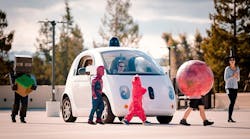Google self-driving cars, in their quest to handle every road encounter, common or obscure, have covered a lot of ground. A woman in an electric wheelchair chasing a flock of geese? Got that situation down. Now the engineers at Google’s self-driving project can also check “what appears to be a papier mache planet Jupiter with legs” and “kid wearing a series of spray painted cardboard boxes to resemble Minecraft character Enderman” off their list.
Last week, Google invited its employees to bring their costumed children to a Halloween party at its Mountainview, Calif., headquarters to give the cars’ sensors some extra practice. A pint-sized crew anchored by an Angry Bird with attitude paraded around the car so sensors could collect data and give engineers a better sense of how small people with lots of energy move when they’re decked out for trick-or-treating.
The Google car is able to classify an object in one of four ways —pedestrian, cycle, vehicle or other object, a Google spokesman told IndustryWeek. It will use that recognition to predict how the object may behave and then make decisions on how the car should react, taking into consideration other data like speed, direction and erratic movements. Having the costumed kids walk around the car brings a new set of very specific data--so when a Google car encounters a kid in a tall, pointy hat, the car knows by movement and basic shape that it’s a kid and not, say, a go-cart with a cone-shaped antenna on top.
The more examples that are part of the car’s machine learning, the better the chance of recognition.
“We teach our cars to drive more cautiously around children,” Google said in a blog post about the Halloween parade. “When our sensors detect children—costumed or not—in the vicinity, our software understands that they may behave differently. Children's movements can be more unpredictable—suddenly darting across the road or running down a sidewalk—and they’re easily obscured behind parked cars. So even if our cars can’t quite appreciate the effort the kids put in dressing as their favorite character from Frozen, they’re still paying full attention.”
Right now, Google cars are only tooling around the magical lands of Mountainview and Austin, Texas—25 of the plush-toy-worthy white “bubble” cars and 23 Lexus RX450h SUVs. As of October, they’d traveled more than 1.2 million miles autonomously—10,000 to 15,000 per week on public streets. The company says it has no plans to introduce the cars to ghouls and goblins in say, Cleveland, where they’d have a heck of a time figuring out how to classify tailgating Browns fans. Maybe there should be a fifth category: perennially disappointed objects that really know how to party.



